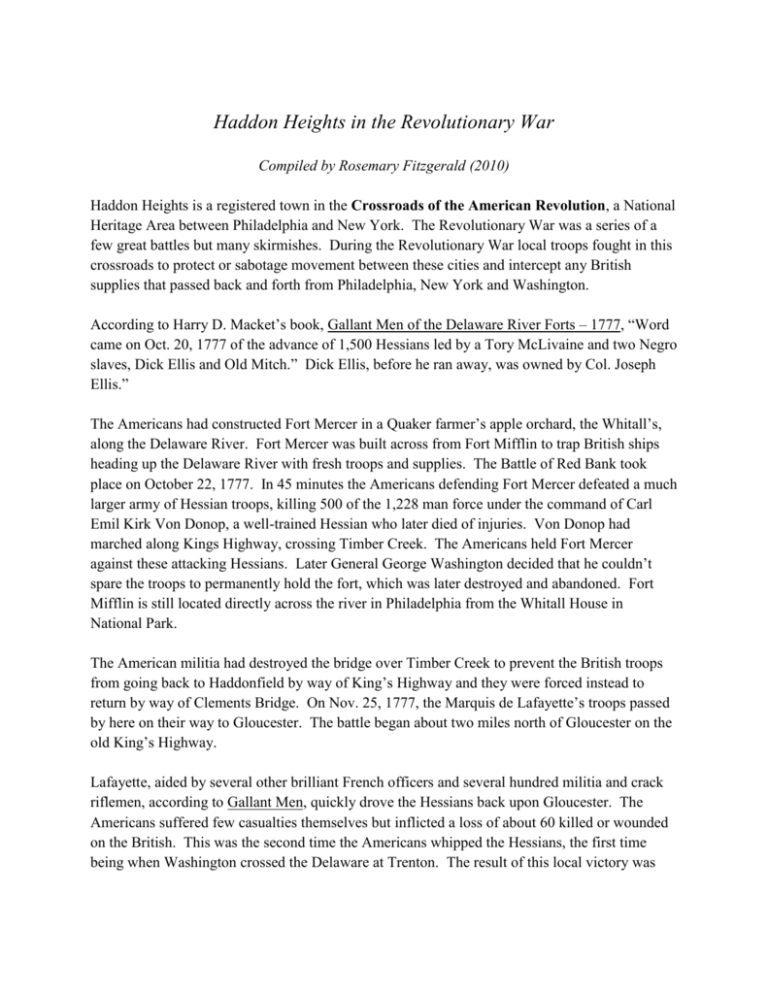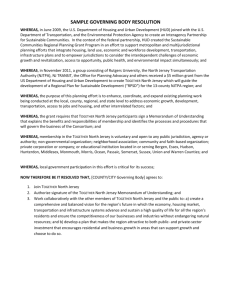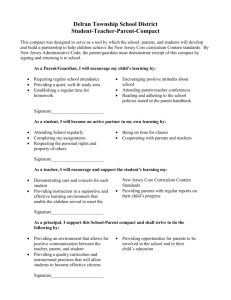Haddon Heights in the Revolutionary War
advertisement

Haddon Heights in the Revolutionary War Compiled by Rosemary Fitzgerald (2010) Haddon Heights is a registered town in the Crossroads of the American Revolution, a National Heritage Area between Philadelphia and New York. The Revolutionary War was a series of a few great battles but many skirmishes. During the Revolutionary War local troops fought in this crossroads to protect or sabotage movement between these cities and intercept any British supplies that passed back and forth from Philadelphia, New York and Washington. According to Harry D. Macket’s book, Gallant Men of the Delaware River Forts – 1777, “Word came on Oct. 20, 1777 of the advance of 1,500 Hessians led by a Tory McLivaine and two Negro slaves, Dick Ellis and Old Mitch.” Dick Ellis, before he ran away, was owned by Col. Joseph Ellis.” The Americans had constructed Fort Mercer in a Quaker farmer’s apple orchard, the Whitall’s, along the Delaware River. Fort Mercer was built across from Fort Mifflin to trap British ships heading up the Delaware River with fresh troops and supplies. The Battle of Red Bank took place on October 22, 1777. In 45 minutes the Americans defending Fort Mercer defeated a much larger army of Hessian troops, killing 500 of the 1,228 man force under the command of Carl Emil Kirk Von Donop, a well-trained Hessian who later died of injuries. Von Donop had marched along Kings Highway, crossing Timber Creek. The Americans held Fort Mercer against these attacking Hessians. Later General George Washington decided that he couldn’t spare the troops to permanently hold the fort, which was later destroyed and abandoned. Fort Mifflin is still located directly across the river in Philadelphia from the Whitall House in National Park. The American militia had destroyed the bridge over Timber Creek to prevent the British troops from going back to Haddonfield by way of King’s Highway and they were forced instead to return by way of Clements Bridge. On Nov. 25, 1777, the Marquis de Lafayette’s troops passed by here on their way to Gloucester. The battle began about two miles north of Gloucester on the old King’s Highway. Lafayette, aided by several other brilliant French officers and several hundred militia and crack riflemen, according to Gallant Men, quickly drove the Hessians back upon Gloucester. The Americans suffered few casualties themselves but inflicted a loss of about 60 killed or wounded on the British. This was the second time the Americans whipped the Hessians, the first time being when Washington crossed the Delaware at Trenton. The result of this local victory was the commissioning of Lafayette with the rank of Major General of the Continental Army by Congress. Washington was quartered in Valley Force during the winter of 1777-78 By June of 1778, the entire British population was fleeing Philadelphia in front of a re-organized American army buoyed by a new French alliance. The French fleet was on its way and the British didn’t want to be locked into Philadelphia. The British will concentrate their forces in New York. When the British left Philadelphia under the command of Sir Henry Clinton who had replaced Sir William Howe as Commander of British Troops, they split into two groups – one traveling along Cooper’s Creek. The British forces of 15,000 soldiers and 1,500 large wagons traveled about 8 – 10 miles a day. Local militia harassed the British by destroying bridges, including the corduroy bridge over King’s Highway, cutting down trees to block roads and firing into the lines. The British in turn ransacked homes and businesses, including the Glover house and Fulling Mill, stole food and livestock and ravished the Patriot women. “Skirmishing was constant,” writes Capt. Johann Ewald, a German mercenary serving with the British. And the heat was deadly. “Many men fell and lost their lives because of the intense heat, and due to the sandy ground which we crossed through a pathless wood where there was no water to be found on the entire march,” wrote Ewald. On June 27, the Continental Army closed in on the slow moving British at Monmouth Courthouse. 2 The Hinchmans In the spring of 1699, John and Sarah Hinchman came from Long Island and purchased 1,000 acres of land from John and Priscilla Huggs Collins, land that her father had willed to her. Some 200 years later, this land would become the town of Haddon Heights. Sarah and John built a one over one room brick house on the banks of King’s Run, a small branch of Newton Creek. The house was called, somewhat pretentiously, The Manor House, and was almost immediately doubled in size. Sarah and John had nine children. After her death, John remarried and his children totaled 13. Three generations of Hinchmans lived in the house although John divided his land and his son; John II built a house on a 200 acre tract where the Barrington Circle now stands. John III was appointed Sheriff of Gloucester County by the Royal Governor; he served in the General Assembly from 1769-1775; he was a Justice of the Peace and later Judge of the Quarter Sessions. The tide of opinion was racing toward independence, according to Loyalism in Gloucester County, but John Hinchman could not be swept along. On May 28, 1776, at the Courthouse in Gloucester, he read a protest against the election of the Provincial Congress which even then was considering plans for declaring independence. This protest statement marked the end of his public career. The Declaration of Independence soon followed on July 4, 1776. New Jersey was trying to control the activities of the Tories who were attempting to prevent the rebellion from succeeding. A law was adopted in July 1776 which defined treason and specified the death penalty. In August 1776, a resolution was passed for sequestering the estates of all who left home to join the enemy. New Jersey passed Test Laws in the fall of 1776 which required swearing allegiance to the new State. An opportunity to take an oath of allegiance to the new country was offered to those persons “who have been seduced from their allegiance” but “since became sensible of their error” in June 1777, according to Loyalism in New Jersey. John Hinchman did not take this “opportunity.” In 1777 John Hinchman III was committed to jail for disloyalty by the Council of Safety, because he had declared his allegiance to the Crown. He joined the British Army about March 1778 and his lands were declared forfeited by an Act of Assembly in December 1778 and were confiscated, according to Gloucester County records. He and his family were run out of town, and he fled to New York and then England, 80 years and three generations after their grandfather’s settlement along King’s Run. The children of John Hinchman II, however, had deeded interest in their father’s land and decades later brought a Suit of Ejectment against the new owner, Elijah Clark, who had been deeded the land on September 7, 1779. A court battle ensued which resulted in the land being returned to the William Hinchman. William Hinchman’s children sold the land, which formed the east side of Haddon Heights to John Wilkins in 1799. 3 Colonel Joseph Ellis Colonel Joseph Ellis of Burlington City came down and married John and Sarah Hinchman’s granddaughter, Mary, who was the daughter of Jacob Hinchman and they were deeded the house at 1006 Sycamore, what is now the oldest frame building standing in Camden County. The original one-over-one room house was constructed about 1720 and boasts medieval-style brick and batten walls, commonly used in England in the 14th century. The newer federal style main addition of the house is attributed to Colonel Ellis. Colonel Ellis was a veteran of the French and Indian Wars of 1755. He enlisted with the New Jersey Militia and fought with the Gloucester County Militia. He is frequently mentioned in Gallant Men, fighting at Fort Mercer and Cooper’s Creek. Follows is a letter from General Washington to Colonel Ellis. General Washington Head Quarters Valley Forge January 18, 1778 To Brigadier General Joseph Ellis of New Jersey Militia on: Sir: I am pleased to hear by yours of the 15th, instant, that you have been appointed to the Command of the Brigade last Newcomb’s. From the Character given of you by General Greene, I have every reason to expect that nothing will be wanting on your part to excite a proper Spirit among the people, and to give the most effectual opposition to any parties of the Enemy who may attempt to ravage your Coast. If the State has no Ammunition belonging to it, you must send an Officer to me, with an account of the Quantity wanting, and I will supply you. I think when the Army came from Morris Town, we left two Iron four pounders there belong to Jersey. You will therefore send an Officer to inquire for them and to bring them down to you if he finds them there. But lest they should have been removed, I inclose you an Order on the Commissary of Military Stores at Allen Town in Northampton County, for two Iron four pounders with fixed Ammunition for them. You should inquire what is done with the light Iron Guns that were removed from Red Bank, if you can find any of them that will suit you, you had better get two of them fitted up and only send for the fixed Ammunition to suit them from Allen Town, This will save much trouble. Although it will be inconvenient to the Inhabitants of Burlington, Gloucester and Salem to remove their Stock back, I would still have you do it as effectually as possible, or the Enemy will certainly make a sweep of them one day or another. What are proper for Beef, the Commissaries will take off their hands and for others I should think it would be in the power of every farmer to carry back some forage for them. 4 I have nothing to do with the appointment of the Staff in the Militia, more than any other Officers, and therefore cannot interfere. I should suppose you had better yourself appoint persons who are suitable and get them confirmed by the Governor. I am, George Washington After Mary’s death, Col. Ellis married Abigail Bloomfield, sister-in-law of Joseph Bloomfield. Col. Ellis lived in the house from 1760 until his death in 1796. Upon his death his widow, Abigail, freed his slave and, a Quaker, worked toward abolition. On her death the house was transferred to Abigail Bloomfield, and then later to Joseph, who later became governor of New Jersey, on December 25, 1807. Joseph Bloomfield sold the property in 1809 to Nathan Lippincott, bringing the Lippincott family to the area from Gloucester Township. Maj. Bloomfield, a native of Woodbridge, had served during with the Third New Jersey Regiment from 1776 to 1778. His diary, edited and published by Mark Lender and James K. Martin, Citizen Soldier – Revolutionary War Journal of Joseph Bloomfield, provides a personal account of the war experiences of a New Jersey soldier. Maj. Bloomfield was injured at the Battle of Brandywine and, after his wound healed, also served at the Battle of Monmouth. His diary notes that when Congress voted to reduce the New Jersey Brigade to three regiments for the 1779 campaign, Bloomfield voluntarily stepped aside but remained a committed Patriot. A June 1778 notation in his diary records, “We kept large commands on the lines below Haddonfield.” One of the final entries in March 1780 after receiving commission for several court positions in four South Jersey counties notes that he and his wife, “removed with two servants to Haddonfield, six miles from Philadelphia and in the direct road from Egg Harbor and the Seashore.” John Glover John Glover, originally from England, came from Flushing, Long Island. He married Mary Thorne, also a granddaughter of John Hinchman. John Thorne left his house, later known as the Hatcher House (demolished), to his son-in-law John Glover. John Glover’s son was the first of seven generations of Glovers to live in the house now on Sylvan Drive. John Glover declared his allegiance to the Patriot cause, joined the Continental Army and was promptly “read of out meeting” by his Quaker congregation. John Glover III gave an interview many decades ago where he recalled his grandparents Revolutionary War history. At that time British supply routes had been intercepted and British 5 soldiers organized foraging parties, confiscating large quantities of grain, poultry, cattle and horses from American farmers and residents. Cornwallis also reportedly demanded food from his grandmother and she refused. He also demanded the silver buckles from her husband’s shoes but was also refused. As he stormed out the door, he muttered, “We’ll shoot the . . . . . ruffle at sunset.” The Glover Fulling Mill where hand woven fabrics were washed and fulled was a stone’s throw from the Glover farmhouse (now 1212 Sylvan). The fulling mill machinery was destroyed by Hessian soldiers on their way to Trenton. Tradition says that the fabric for the first flag was fulled for Betsy Ross at the Glover Fulling Mill. Mrs. Ross was a customer of the mill and lived in nearby Gloucester. The mill burned down in 1821 and was rebuilt a year later. After the Civil War it fell into disuse and had been torn down by 1918. The remains of the foundation can be found on the grounds of the former Public Works plant. During Christmas week in 1937, Works Progress Administration workers constructing footpaths along the border of King’s Run near Kings Highway unearthed a three and a half pound cannonball buried about 18 inches deep and made of bog iron. The cannonball had been made in the furnaces at Batsto, Atsion, Weymouth or some other bog iron furnace in South Jersey. The cannonball is on display at the Haddon Heights Library. The Chalkley Glover House, located on New Jersey Avenue was also built by the Glover family in two sections. The house is not named for the original owner but rather for one of their descendants, Chalkley, who was the first moderator of Centre Township when it was created from Gloucestertown Township in 1855. The house was reported used as a hospital after the Battle of Gloucester. Four privately owned and continuously occupied colonial houses remain in Haddon Heights, on the Crossroads of the American Revolution: Hinchman Hurley House at 1019 North Park Drive, Colonel Joseph Ellis House on 1009 Sycamore, John Glover House at 1212 Sylvan Drive and Chalkley Glover House on New Jersey Avenue. All are listed on the local, State and National Register of Historic Places. 6






